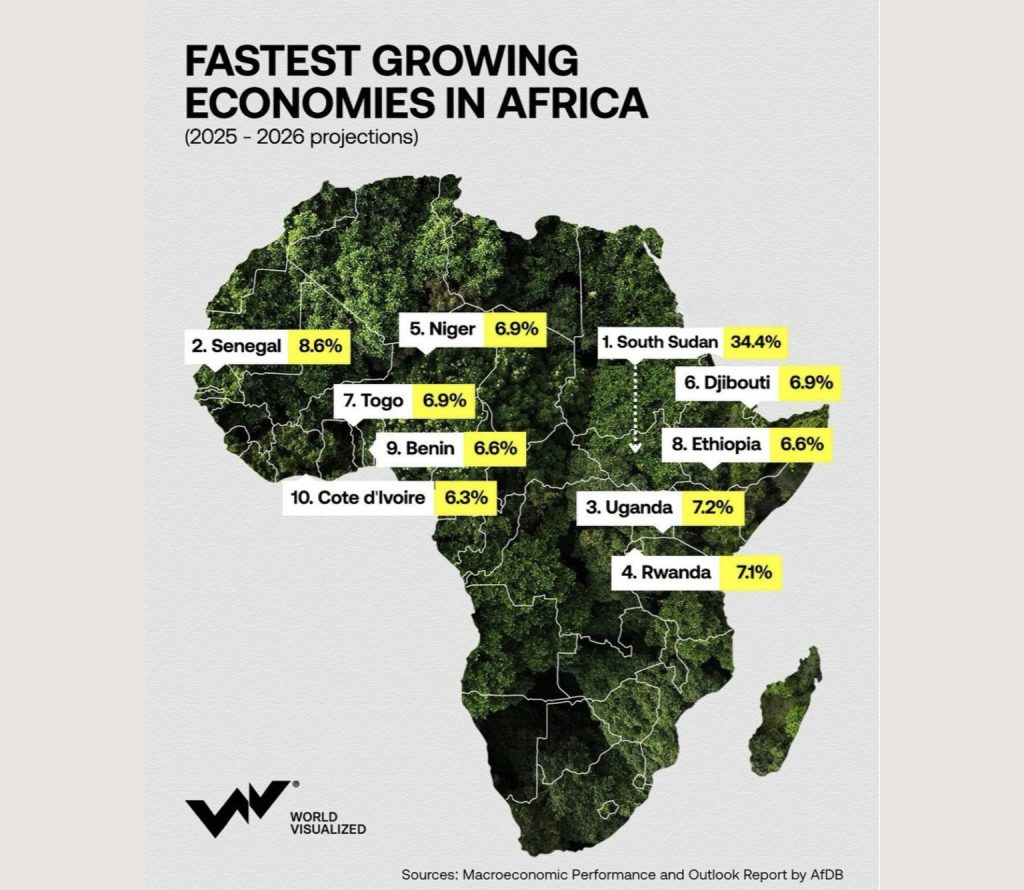

The African Development Bank Group’s (AfDB) projections for 2025-2026 highlight a dynamic economic landscape in Africa, with several countries poised for robust growth. However, the specific figures and rankings you provided don’t fully align with the latest AfDB reports or other reliable sources like the IMF’s World Economic Outlook. Let’s clarify the top 10 fastest-growing African economies for 2025 based on available data, critically examining the projections and key drivers.
Top 10 Fastest-Growing African Economies (2025 Projections)
Based on the AfDB’s Macroeconomic Performance and Outlook (February 2025) and IMF projections (April 2025), here’s a corrected and evidence-based list of Africa’s growth champions for 2025, with growth rates and drivers:
- Niger 🇳🇪: ~7.1–11.2%
- Driver: Significant oil exports via a 2,000-km pipeline to Benin, alongside uranium mining and agricultural output.
- Context: Despite political instability post-2023 coup, Niger’s resource wealth fuels growth, though sanctions and ECOWAS exit pose risks.
- Senegal 🇸🇳: ~7.9–8.4%
- Driver: Emerging oil and gas sector, infrastructure investments, and political stability under new leadership.
- Context: Senegal’s consistent reforms and energy projects position it as a West African powerhouse.
- Rwanda 🇷🇼: ~7.0–7.1%
- Driver: Diversification into technology, tourism, and agriculture, supported by stable governance and private sector growth.
- Context: Rwanda’s business-friendly policies and logistics hub ambitions drive sustained growth despite regional tensions.
- Benin 🇧🇯: ~6.5–7.2%
- Driver: Port development, regional trade with Nigeria, and agricultural productivity.
- Context: Benin’s proximity to Nigeria and governance improvements make it an underrated investment destination.
- Ethiopia 🇪🇹: ~6.4–6.6%
- Driver: Infrastructure projects, manufacturing, and services growth, despite political and ethnic federalism challenges.
- Context: Ethiopia’s potential is tempered by internal conflicts, but its large market and reforms keep it competitive.
- Uganda 🇺🇬: ~6.0–6.2%
- Driver: Oil production, infrastructure projects, and a growing services sector.
- Context: Uganda benefits from East Africa’s integration, with investments in energy and tech boosting growth.
- Tanzania 🇹🇿: ~6.0–6.1%
- Driver: Natural gas, tourism, and transport/energy infrastructure.
- Context: Tanzania’s regional scalability in the East African Community (EAC) and stable growth trajectory make it a hotspot.
- Côte d’Ivoire 🇨🇮: ~6.3–6.8%
- Driver: Diversified economy with strong agricultural exports (cocoa), manufacturing, and industrial reforms.
- Context: Consistent governance and business environment improvements drive Côte d’Ivoire’s resilience.
- Djibouti 🇩🇯: ~6.2–6.9%
- Driver: Strategic logistics and shipping hub, with investments in ports and transport infrastructure.
- Context: Djibouti’s trade hub status in the Horn of Africa supports steady growth, though debt risks linger.
- Togo 🇹🇬: ~6.0–6.9%
Clarifications and Notes
- South Sudan 🇸🇸: The +34.4% growth figure you mentioned is not supported by AfDB or IMF data for 2025. South Sudan’s economy is projected to contract by ~4.3% in 2025 due to conflict, declining oil production, and macroeconomic instability. Earlier high growth estimates (e.g., 2023) were likely due to temporary oil revenue spikes, but current projections are negative.
- Regional Trends: East Africa leads as the fastest-growing region (5.3% in 2025, 6.1% in 2026), driven by Rwanda, Uganda, Ethiopia, and Tanzania. West Africa follows with 4.6% growth, led by Senegal, Benin, and Côte d’Ivoire.
- Continental Outlook: Africa’s real GDP growth is forecast at 4.1% in 2025 and 4.4% in 2026, outpacing the global average (3.2%). The continent remains the second-fastest-growing region after Asia, with 24 countries expected to exceed 5% growth in 2025.
- Challenges: Despite optimism, Africa faces hurdles like geopolitical tensions, climate disasters, and conflicts (e.g., Sahel, Horn of Africa). Growth rates below 7% are insufficient for significant poverty reduction, and debt distress risks persist.
Why Africa is a Growth Frontier
These projections underscore Africa’s resilience and diversity:
- Hydrocarbons: Niger and Senegal leverage oil and gas to boost GDP.
- Infrastructure: Investments in ports (Benin, Djibouti, Togo) and transport (Ethiopia, Uganda) enhance trade.
- Tech and Innovation: Rwanda’s fintech and logistics hub ambitions attract global attention.
- Agriculture and Trade: Benin, Côte d’Ivoire, and Togo capitalize on regional markets and agricultural exports.
- Policy Reforms: Stable governance in Rwanda, Senegal, and Côte d’Ivoire draws foreign investment.
For investors and entrepreneurs, these economies offer opportunities in energy, logistics, tech, and agriculture. However, risks like political instability, debt, and climate shocks require careful navigation.
